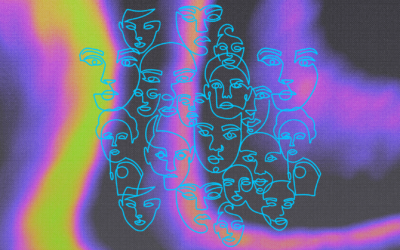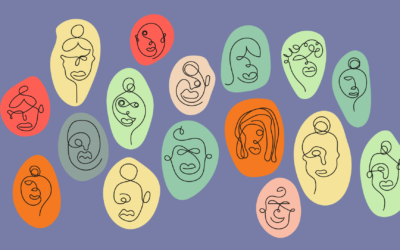
The political profile of young people after the Tempi Train Tragedy: Emotions, ideological identification and expectations
Key Conclusions
- The tragic train accident that took place in Tempi, Greece was experienced as a “moral shock”.
- The predominant emotions experienced after the accident were rage and shame.
- The transformation of anger into a moral imperative for action explains the mass participation of people with no previous organisational involvement in protest
- The action’s duration depends on the balance between positive (hope, indignation) and negative emotions (rage, shame).
- Rage without hope rarely results in coordinated forms of collective action. Shame without attributing responsibility to powerful decision-making parties does not turn into indignation and instead has a paralysing effect and doesn’t usually lead to collective action.
- The prevailing feelings today in relation to the Tempi accident are, consistently, negative: Rage (43.7%), Shame (17%), and Despair (19.7%). “Faith that the situation will change for the better” is detected in just 3.1% of the participants.37.8% of the participants participated in the mobilisations.
- The majority of the participants (64.6%) did not join an organised block, while the percentage of those who joined a protest for the first time was relatively small (13.6%) compared to 84.9% who have participated in such mobilisations in the past.
- Those who participated in the mobilisations were informed about the mobilisations mainly through Social Media (54.3%) and their friends and family (23%)
- The main responsibility for the Tempi accident is more or less evenly distributed between the current government 59.5% and all the previous ones 58.3% and, along the same lines, the public and private sector (28.8% and 22.8% respectively).
- The most prevalent preferred solution to remedy the situation is considered to be the re-nationalisation of all passenger services (38.3%).
- “Expensiveness – Inflation” (43.4%), “Economy – Growth” (43%), and “Justice – Transparency” (40%) shape young people’s voting intention more than the “Tempi tragedy” (18.5%).
- In terms of ideological identifications, individualism has a relative predominance (22.2%), while there also seems to be a tendency towards cultural progressivism ranging from Social Democracy to Anarchism (35%). A significantly high percentage (19.3%) stated “IDK/NA”.
- The crisis of confidence affects the entire range of institutions horizontally. Higher rates of distrust are expressed for the “Political Parties” (88%) and the “Government” (75.4%), while the “Army” and the “Independent Authorities” (57.7% and 56.9%, respectively) score lower (participants see them as being more trustworthy). There is also an undeniable lack of trust in the media with TV (86.7%) being at the top of the list.
- The crisis of confidence in political parties and the government does not translate into an intention to abstain from elections. 82.1% stated that they will vote in the 21st May elections and 77.5% stated they intend to vote in the event of a run-off.
- Given the high degree of distrust towards the government and political parties in general, voting is a defensive political act and a form of low-expectations political participation practice. An overwhelming 66.2% of the participants believe that their lives are going to be improved through personal effort.
Introduction
The news of the fatal accident in Tempi was widely experienced as a moral shock (Jasper 1997), sparking -almost as an instant reflex-, a multitude of collective manifestations of discontent (demonstrations, symbolic protest actions, strikes) that spread to 73 cities across Greece and brought to the streets unknown groups of protesters. The starting point for the present research, was an intention to investigate the effects that this particular dramatic event had on the political perceptions, the assertive dispositions as well as the emotional fluxes and motivations for political participation of the (extended) group of young people (17-34) considered to be the protagonists of protest events (Rucht, Koopmans & Neidhart 1999; Fillieule 1999; Serdadakis 2011).
Given the above, this analysis will focus on three major subject areas.
The first concerns the participants’ profile. In this context, particular emphasis will be placed not so much on the specific group’s “ostensible”, demographic/sociographic traits, but on the less visible aspects of political participation: the emotional and moral imperatives calling for collective action under the given circumstances.
The second, will attempt to document the overall processes of the formation of collective identifications and meanings for this particular age group. Dimensions of political behaviour related to the political context in which they are manifested, and to more stable variables of political reality, namely, the degree of trust in institutions and ideological predilections as well as the participants’ organisational affiliations, are at the core of this section.
The third focuses on the future and aims at demonstrating what seems to be perceived as virtuous and/or relevant political action. In this context, the mapping of the participants’ political expectations in combination with the preferred practices for achieving them is expected to shed light on some of the currently observed paradoxes regarding political stances and preferences.
Ι. Emotional flows, cognitive prompts and motivations for participating in the protest events after the Tempi train accident
The tragic accident at Tempi, as mentioned above, was experienced as a “moral shock” that came to disrupt routines and burst the bubble of common certainties (safe and reliable transportation, social responsibility, etc.), on the grounds of which any minimal social agreement and/or silent disagreement with everyday life’s organisation and reproduction patterns is based.
The concept of “moral shock”, as described in the relevant literature (Jasper & Poulsen 1995; Jasper 1997), can help us better understand how, on hearing of an event that is deemed to be unfair, in this case the fatal train accident, people who are not embedded in social networks or political organisations participate in protest events en masse.
The interpretative key in this case is the emerging feelings of anger/rage and/or shame. These emotions translate into a moral imperative for taking action and may explain the mass entry of people with no previous organisational involvement in protests due to a previous lack of strong solidarity ties, or of a solid ideological identity (factors that encourage action).
However, as suggested in relevant studies, there is a continuous flow of emotions in any action flow, and what will ultimately determine its duration and characteristic attributes is the balance between positive (hope, indignation) and negative emotions (rage, shame).
More specifically, rage without hope rarely results in coordinated forms of collective action. Instead, it seems to favour other, often individual, forms of resistance or expression of discontent (McAdam & Aminzade 2001; Kotronaki & Seferiades 2012). Respectively, if shame does not acquire a legitimating basis (attributing causal responsibility to powerful decision-making parties) in order for it to be able to be transformed into (sacred) indignation, the paralytic effect caused by the shock, can’t be transformed into active political action.
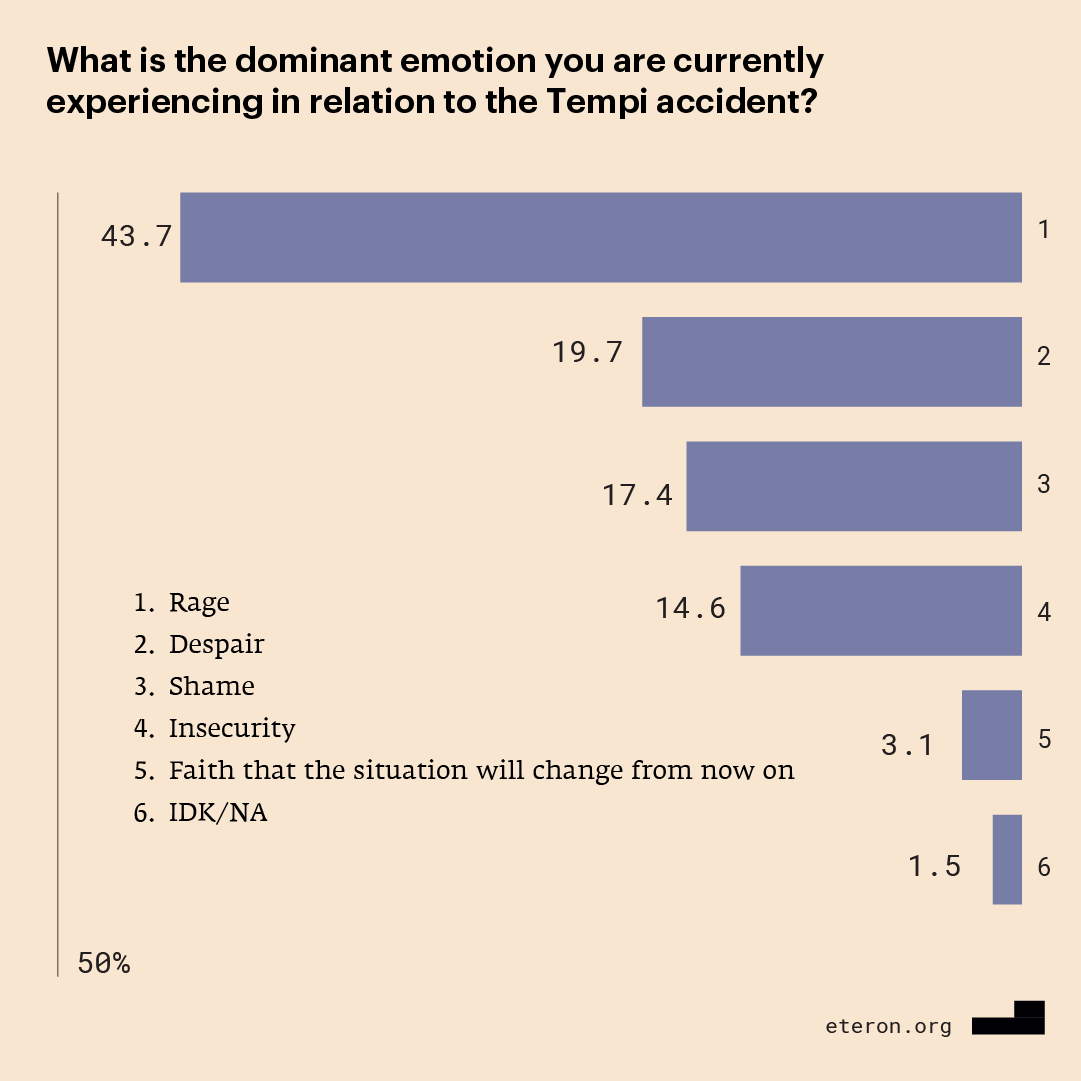
Graph 1
By observing the findings of the research at hand, it appears that the above theoretical assumptions are substantiated. When asked “What is the dominant emotion you are currently experiencing in relation to the Tempi accident”, 43.7% of the total sample replied that they felt “Rage”, 17% felt “Shame”, 19.7% experienced a sense of “Despair”, while only 3.1% of the participants stated that they had “Faith that the situation will change from now on”.
Subsequently, we asked the 37.8% of the sample who stated that they participated in protest actions over the Tempi accident if “In the mobilisations, you participated in an organised block?”, and 64.6% replied “No, I went alone or with my friends” compared to 31.1% who stated that “Yes, I joined an organised block”. Similarly, to the relevant question “How did you get informed about the mobilisations that took place?” 54.3% answered “From Social Media” and only 10.6% replied “Through Political Collectives/ Associations/ Unions”.
Lastly, given the age group to which the participants belong and the exceptional circumstances caused by the pandemic in the past few years, it is particularly interesting that when asked “Were the protest rallies regarding the Tempi accident the first time that you participated in rallies/protests over a social issue?”, 84.9% replied “No” (compared to 13.6% who said “Yes”).
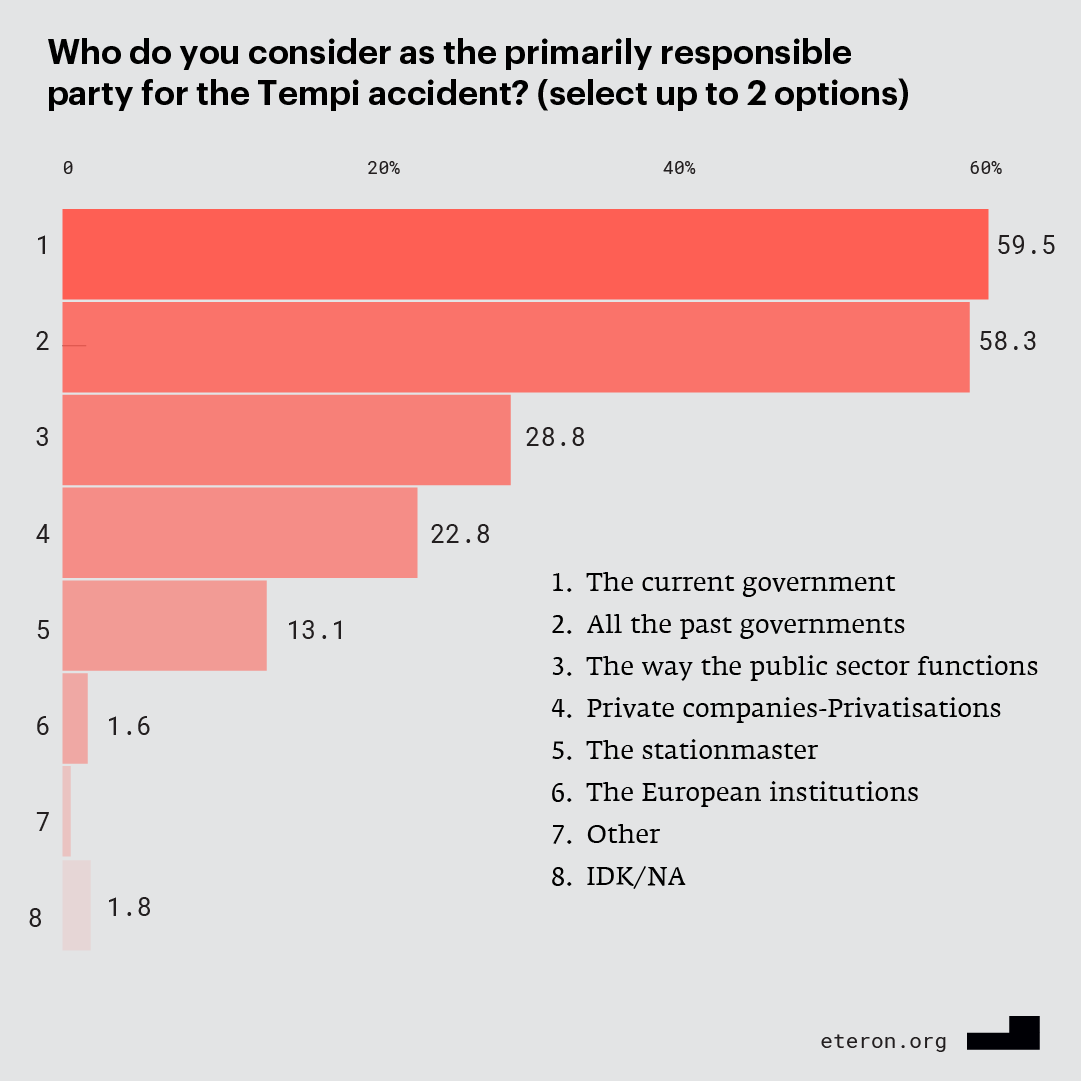
Graph 2
At the same time, looking at the process of attribution of responsibility through the analysis of the diagnostic frame (problem definition and attribution of responsibility), the resulting pattern is not particularly clear-cut, as responsibility is almost evenly distributed among the dominant political actors (the government 59.5%, all past governments 58.3%), as well as the public and private sector (28.8% and 22.8% respectively).
Things are less confusing when we focus on the prognostic frame (proposed solutions to existing problems), where the option “Re-nationalise all the passenger services (Trainose/Hellenic Train)” was picked by 38.3% of the participants and took a lead over the alternatives.

Graph 3
From the above it can be concluded that, indeed, there are types of emotions that can trigger collective action, mainly in the form of highly emotional protests (marches remain the dominant form of protest, with 44.8%), even in circumstances where the basic organisational preconditions for its emergence (pre-existing assertive vehicles and attachements, solidarity bonds and common value systems) are absent.
However, it is important to stress that emotions alone probably do not suffice to give collective action duration over time. In the absence of established (organisational) spaces of solidarity and reciprocity, as well as spaces where the process of forming collective identities and communities of values can take place, those interpretive frames that can identify and decode the current reality by forging motivations for further action (Snow et al., 1988), the expectation of social change through collective action (Goldstone & Tilly, 2001) fades relatively quickly. As a consequence of all of the above, any assertive dynamics developed through the protest events are gradually receding.
The intense, but ephemeral effect of emotions on the shaping of political attitudes seems to be confirmed by the responses concerning voting intentions. When asked “Which two of the following issues will influence your vote in the May 21 elections?”, the “Tempi tragedy” gets 18.5% while the options “Expensiveness – Inflation”, “Economy – Growth”, “Justice – Transparency” are ahead with 43.4%, 43% and 40% respectively.
II. Weak ideological identifications: Individual success vs institutional failure
If we shift our focus of research beyond the dense and highly emotional context of the Tempi accident, to the more everyday – and arguably more entrenched – political views and identifications of the group being studied, the information and data we collect from our research do not reveal dramatic differences: ideologically diluted political participation, distrust and alienation from the existing institutions.
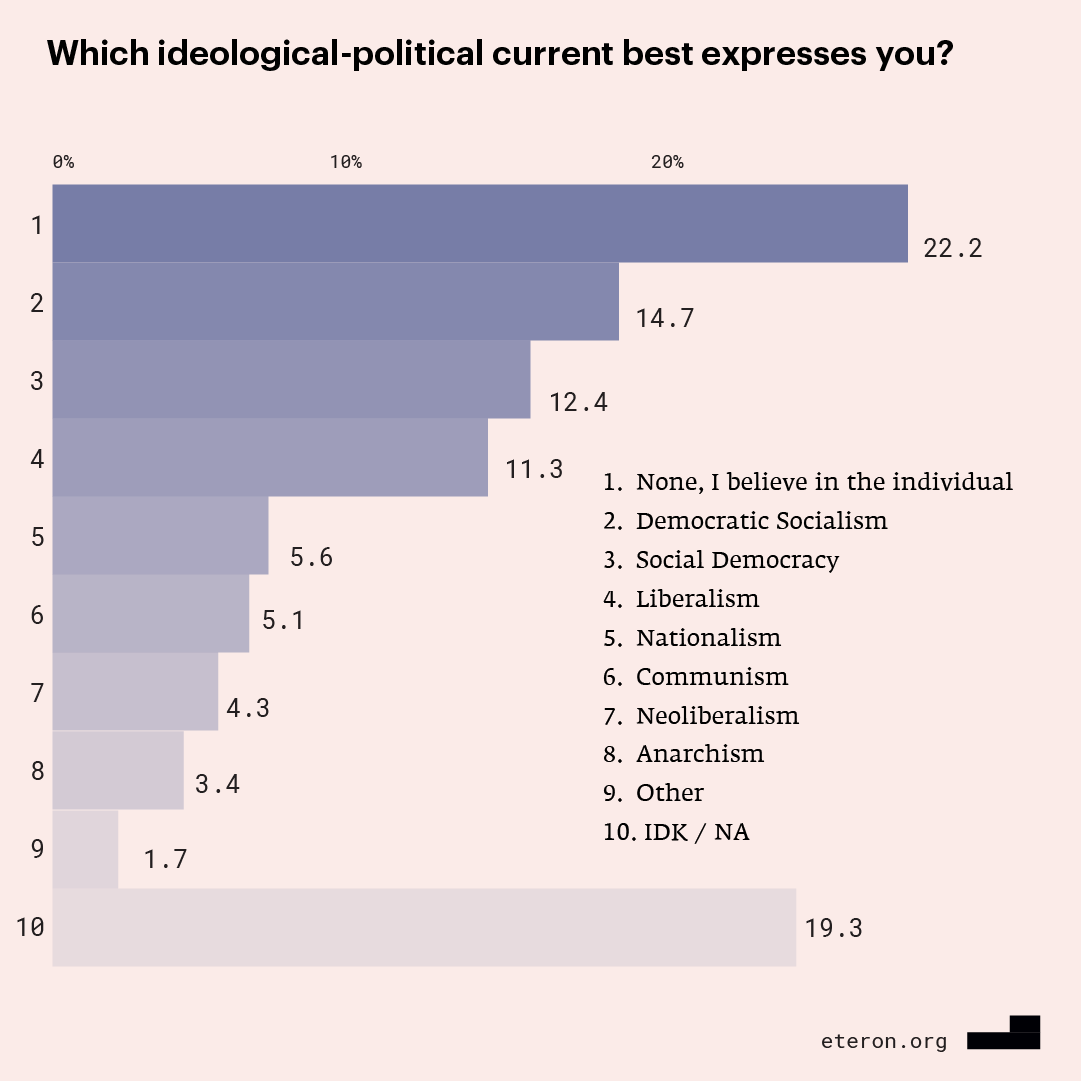
Graph 4
More specifically, when asked “Which ideological – political current best expresses you?”, the most popular answer (22.2%) was “None (No ideology), I believe in the individual”. The option “I don’t know, I don’t want to answer, Not applicable” was in second place with 19.3%, followed by “Democratic Socialism” (14.7%) and “Social Democracy” (12.4%). Next in line are “Liberalism” (11.3%), “Nationalism” (5.6%), and “Communism” (5.1%). At the bottom of the list are “Neoliberalism” and “Anarchism” with 4.3% and 3.4% respectively.
When attempting to compile the fragments of ideological identifications, as they emerge from the research, it would be valid to argue that, despite the relative ideological dominance of individualism (22. 2%) a trend of cultural progressivism extending from Social Democracy to Anarchism is rather noteworthy (35%). This cultural progressivism trend is also detected when we analyse the replies to the question “What is/are the biggest problem(s) that Greece is facing at the moment? (up to 2 answers)”. Here, the predominant issues of the conservative agenda, such as “Immigration/Refugees” and “Greek-Turkish relations” did not rank highly. They received only 11.5% and 5.9% of responses, compared to “Expensiveness/Cost of living” and “Corruption” for which the percentages were significantly higher, (69.4% and 58.3% respectively).
On the other hand, the relative prevalence of the values of individualism is deeply rooted in time and must be seen as the product of the coupling of three different mechanisms (Busso, 2017): a/ the shift of focus from justice to efficiency and, consequently, to governance models that promote the logic of “numbers”; b/ the process of individualisation and the simultaneous marginalisation of social responsibility; and c/ the consolidation of a multilevel governance model in which sometimes the role of civil society organisations appears to be enhanced (provision of social services) while other times it appears to be undermined (possibility of exercising criticism and pressure). This is the long process of depoliticisation, a process of eradicating any political or moral dimension from public life (Held, 2006), in which there is no room for alternative outlets, as everything is subject to the “realm of needs” (Hay, 2007).
The tip of the iceberg of this major process is a phenomenon often referred to as the “(political parties’) ideological convergence at the centre”, a merging which often ends up confusing the body politic or rendering it apathetic. Hence a relatively high percentage (19.3%) of participants appear rather confused as to their ideological self-identification and in response to the relevant question state “I don’t know/NA”.
It is equally interesting to note and further investigate the fact that, while individualism is at the top of the respondents’ preferences, neoliberalism, the ideological rationality that promotes and implements it in its most radical form, is in the penultimate place of choices (4.3%), i.e. only 0.9% more than Anarchism.
In order to interpret this paradox of the connection between “individualism” and “neoliberalism”, we need to conduct more in-depth research focusing on different aspects. However, the findings of the present research may be able to shed light on some of the aspects of this obscure relationship.
It seems, therefore, that in terms of attitudes, neoliberalism has negative connotations as it is not related to some imaginary or abstract value system, but to applied policies, and to specific political forces and institutions that implement them. And, most likely, the relevant responses may reflect a widespread intolerance towards the lived Greek political and social experience of neoliberalism. An intolerance which is also manifested in terms of a generalised crisis of confidence in institutions, as stated when we posed the relevant question.
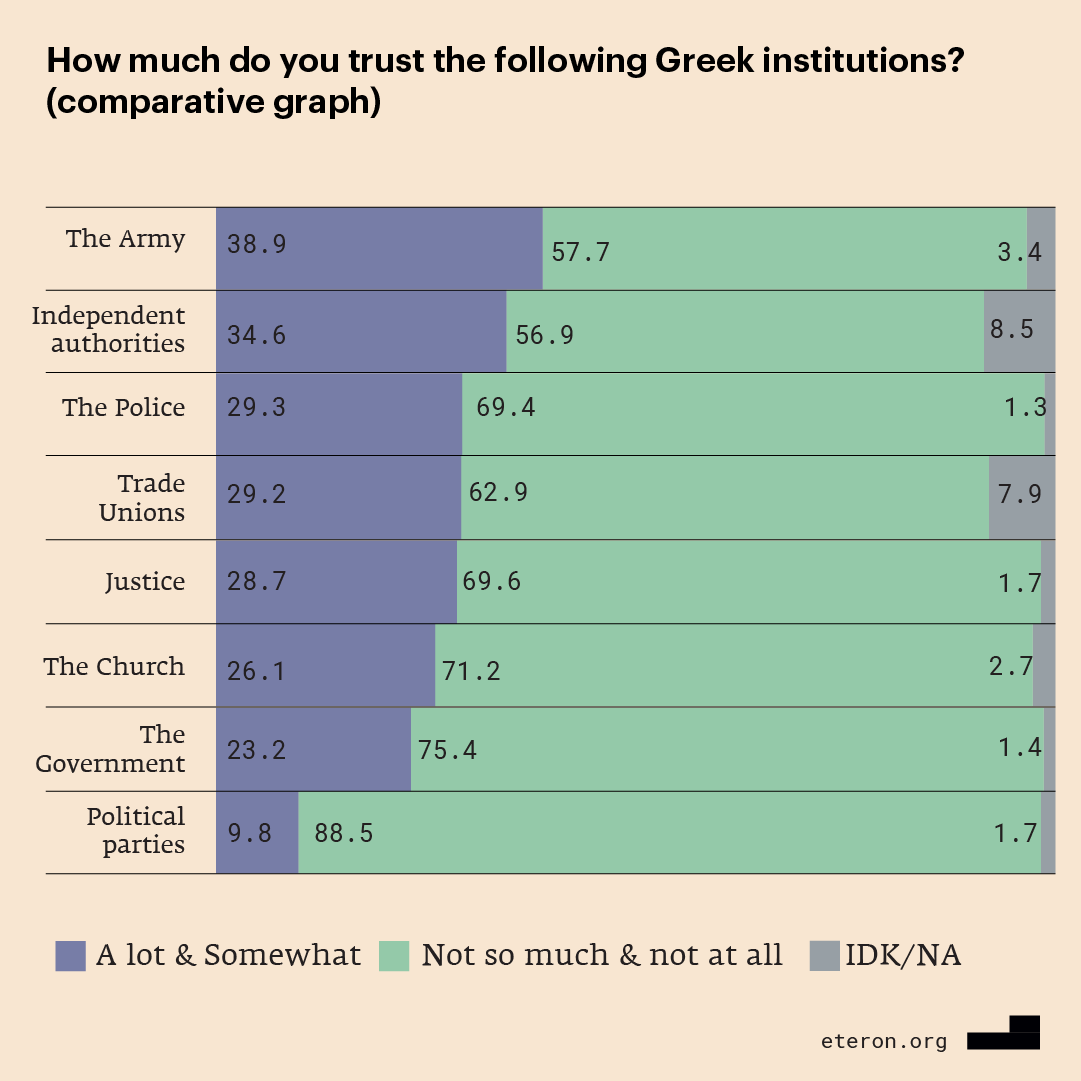
Graph 5
Specifically, when asked “How much do you trust the following institutions in Greece?”, very few people trust “Political Parties”, (88% of all participants replied “Not much or Not at all”. The “Government” (75.4%) comes second on the same negative scale, followed by the “Church” (71.2%), while further down one finds “Justice” and the “Police” with percentages of 69.6% and 69.4%. In a less unfavourable position are the “Workers’ Unions”, the “Army” and the “Independent Authorities” with respective percentages of 62.9%, 57.7% and 56.9%.
III. Low expectations political participation: Life changes vs attitude changes
A search in the relevant literature quickly reveals that there are different (often contradictory) views on the connection between political trust and political participation. According to certain scholars, trust in institutions is a key prerequisite for political participation (Almond & Verba, 1963). According to others, though, distrust is a particular virtue of “citizens with critical minds”, which not only does not deter political participation, but on the contrary pushes citizens to engage in unconventional forms of political participation (Norris 1999; Rosanvallon 2008).
The debate on this issue is ongoing and is further enriched by research findings on other factors that jointly encourage/discourage political participation. But regardless of the different directions this discussion may take, there is one thing that is not disputed: the link between political trust and (conventional) forms of political participation.
With the above considerations in mind, the findings of the present research reveal yet another paradox. The paradox of active participation in conventional forms of action (voting) despite the undeniably high rates of lack of trust in political parties and the government.
Namely, in response to the question “In the past I have participated in: (multiple choice)”, a significant percentage of 70.3% of the participants answered “Elections (I have voted)”. This is followed by participation in “Rallies/demonstrations/protests” (51.9%), “Online activism (adopting a #hashtag/deleting an app)” (51.9%), with 31.3%, and “Strike/work stoppage” (24.3%).
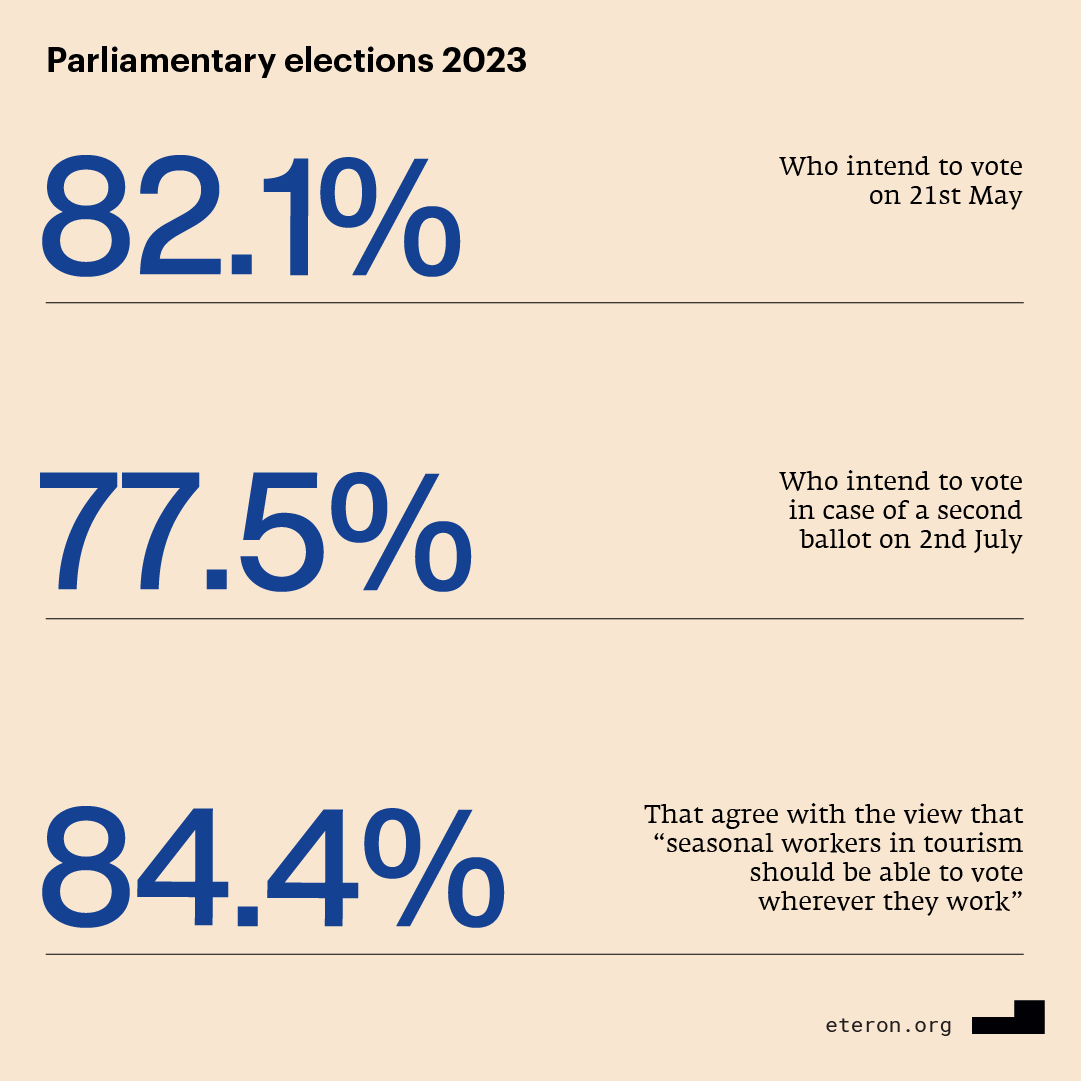
Graph 6
The paradox of participating in conventional forms of action despite the crisis of credibility that runs horizontally through the institutional complex becomes an almost insoluble puzzle when the question “Do you intend to vote in the parliamentary elections taking place on 21 May or not?” is posed and 82.1% state that“YES”, they will. In the same vein, when asked “If no government is formed after the May 21 elections and elections are held again on July 2, do you intend to vote or not?”, the answer again is overwhelmingly in favour of “YES” (77.5%).
This difficult riddle might have led to an analytical and theoretical impasse if the question “How could you improve your life? (multiple options)” had not been asked and had it not been made clear that voting is portrayed as a defensive political act and a form of low-expectation political participation. Undoubtedly, the most popular answer (66.2%) was “By personally making individual efforts”. Coming second by a very wide margin (35.2%) is “By voting (governmental alternance)”, followed by “By participating in collective actions/social movements” (33.2%). Another equally popular option was “By networking and meeting the right people” (24.1%). The prospect of improving one’s life “By participating in political parties” (8.5%) is quite low, while more people than anticipated stated that “I don’t think that my life can be improved” (8.8%), given what that point of view entails.
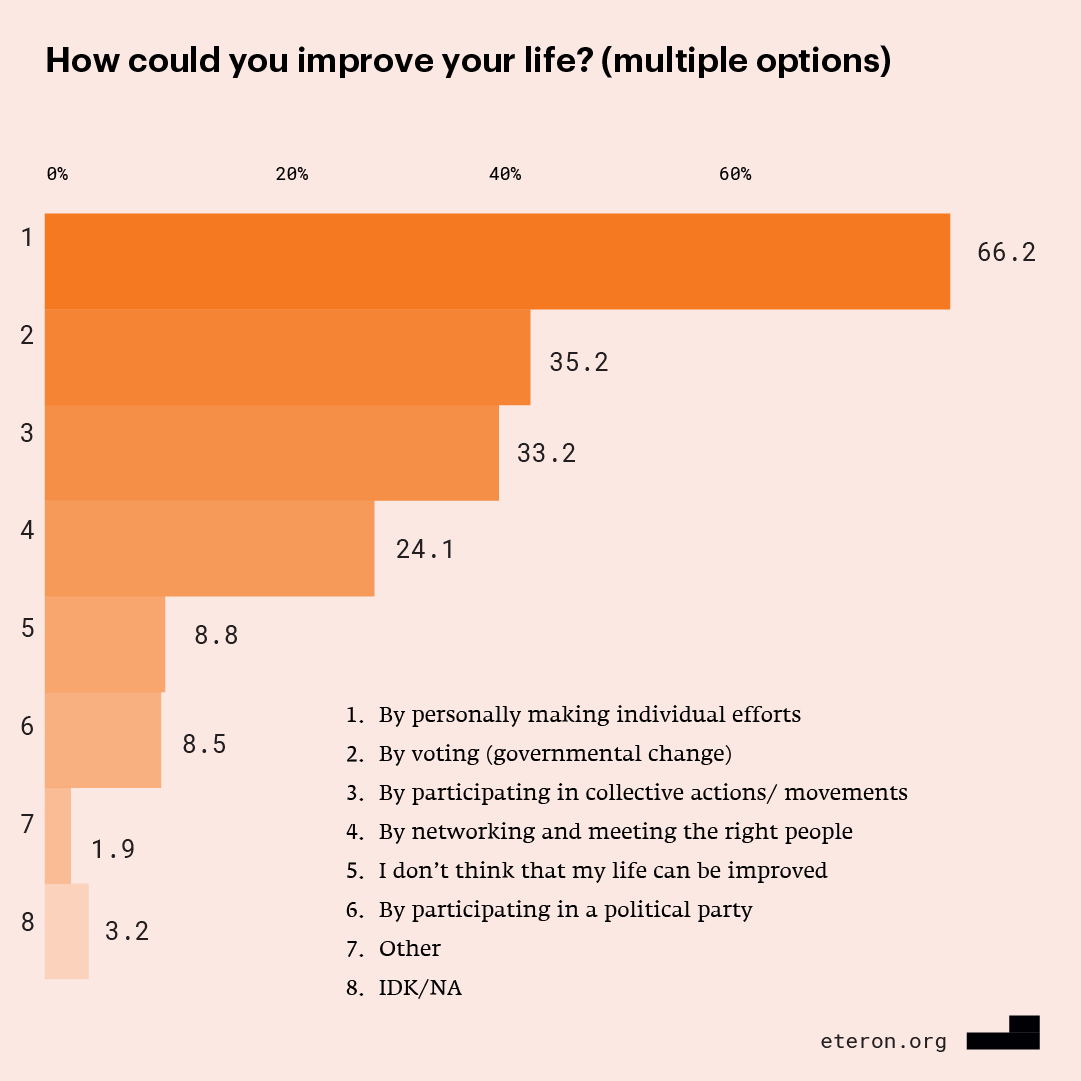
Graph 7
In this case, the responses don’t require much interpretive effort. They come to confirm the hypothesis of the institutionalised process of depoliticisation as described in detail above. But they also come to support the argument that a new form of personalised politics is emerging (Bennett, 2012), which is incubated and reinforced in the informal, digital social networks, the imaginary “personalised” online communities to which the younger generations of the DIY political ethos (Thorson, 2012) are attached through loose ties.
In fact, according to a number of researchers, the space defined by digital political action interacts and functions in a complementary manner with that of institutions, as voters who lack a truly distinct sense of options and voting gradually turn away from institutional politics and turn to the politics of individual, digital emotions. But according to the research, they also largely (33.2%) gravitate towards the most “traditional” sources of emotion: collective actions and social movements.
Bibliography/ References
- Almond, G. & Verba, S. (1963) The Civic Culture: Political Attitudes and Democracy in Five Nations, Princeton: Princeton University Press.
- Bennett L.W. (2012). “The Personalization of Politics: Political Identity, Social Media and Changing Patterns of Participation”, ANNALS, AAPSS, vol.644, p. 20-39
- Busso, S. (2017). “The Depoliticisation of Social Policy at the time of Social Investment: Mechanisms and distinctive features”, Partecipazione e Conflitto, vol.10, issue 2, p. 421-447
- Fillieule, O. (1999). “‟Plus ça change, moins ça change”: Demonstrations in France During the Nineteen-Eighties”, in D. Rucht, R. Koopmans, F. Neidhardt (ed.), Acts of Dissent: New Developments in the Study of Protest, Oxford/NY: Rowman& Littlefield Publishers INC, p. 199-227.
- Goldstone, J., Tilly, C. (2001). “Τhreat (and Opportunity): Popular Action and State Response in the Dynamics of Contention”, in R. Aminzade, J. Goldstone, D. McAdam, E. Perry, J.W. Sewell, S. Tarrow, C. Tilly (ed.), Silence and Voice in the Study of Contentious Politics, Cambridge: Cambridge University Press, p. 179-194.
- Hay, C. (2007). Why we hate politics, Cambridge: Polity Press.
- Hall P. A., & Lamont, M. (eds.) (2013). Social Resilience in the Neoliberal Era, Cambridge: Cambridge University Press
- Jasper, J. M. (1997). The Art of Moral Protest: Culture, Biography, and Creativity in Social Movements, Chicago: University of Chicago Press.
- Jasper, J.M., Poulsen, J.D. (1995). “Recruiting Strangers and Friends: Moral Shocks and Social Networks in Animal Rights and Anti-Nuclear Protest”, Social Problems, vol. 42, p. 493-512.
- Kotronaki, L., Seferiades, S. (2012). “Along the Pathways of Rage: The Space – Time of an Uprising”, in S. Seferiades, H. Johnston (επιμ.), Violent Protest, Contentious Politics, and the Neoliberal State, London: Asghate Publishing, p. 157-170.
- McAdam, D., Aminzade, R. (2001). “Emotions and Contentious Politics”, in R. Aminzade, J. Goldstone, D. McAdam, E. Perry, J.W. Sewell, S. Tarrow, C. Tilly (επιμ.), Silence and Voice in the Study of Contentious Politics, Cambridge: Cambridge University Press, p. 14-50.
- Norris, P. (ed.) (1999) Critical Citizens: Global Support for Democratic Government, Oxford: Oxford University Press
- Rosanvallon, P. (2008) Counter-Democracy: Politics in an Age of Distrust, Cambridge: Cambridge University Press.
- Rucht, D., Koopmans, R., Neidhardt, F.(1999). “Introduction: Protest as a Subject of Empirical Research”, inD. Rucht, R. Koopmans, F. Neidhardt (επιμ.), Acts of Dissent: New Developments in the Study of Protest, Oxford/NY: Rowman & Littlefield Publishers INC, p. 7-33.
- Snow, D.A. (2004). “Framing Processes, Ideology, and Discursive Fields”, in D. A. Snow, S. A. Soule, H. Kriesi (ed.), The Blackwell Companion to Social Movements, (pp. 380-412). Oxford: Blackwell, p.380-412
- Snow, D.A., Rochford, E.B., Worden, S.K., Benford, R.D. (1986). “Frame Analysis Process, micromobilization, and movement participation”, American Sociological Review, vol. 51, p. 464-481.
- Serdedakis N., “Protest events analysis contribution to the understanding of collective action” in Tsiolis G., Serdedakis N., Kallas I., (eds) Research infrastructures and data in the empirical social research, Nisos, Athens, 2011, pp. 349-376.
Read also:

